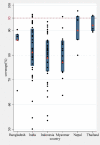Inequality in measles vaccination coverage in the "big six" countries of the WHO South-East Asia region
- PMID: 32271649
- PMCID: PMC7482855
- DOI: 10.1080/21645515.2020.1736450
Inequality in measles vaccination coverage in the "big six" countries of the WHO South-East Asia region
Abstract
The "big six" countries (Bangladesh, India, Indonesia, Myanmar, Nepal, and Thailand) in the World Health Organization South-East Asia Region (WHO SEAR) are currently facing severe challenges in measles elimination and consequent childhood mortality reduction, with inadequacies and inequalities in the coverage of the measles-containing-vaccine first-dose (MCV1) being major obstacles. However, these issues of inequality in MCV1 coverage have not yet been systematically examined. We used data from the latest Demographic and Health Surveys and Multiple Indicator Cluster Surveys. To provide a comprehensive picture of existing MCV1 coverage gaps, data were disaggregated by geographic location, as well as by socioeconomic and nutritional dimensions. National MCV1 coverage ranged from 77% in Myanmar to 92% in Thailand. Only nine of the 104 sub-national districts had achieved the 95% MCV1 coverage goal as set by the WHO. Geographic inequalities were more pronounced in countries with lower coverage levels. Areas in clusters with poor MCV1 coverage performances as well as disadvantaged socioeconomic profiles require increased attention. Inequalities were evident in all countries, except Thailand, and were more pronounced in the sectors of wealth, education, antenatal care (ANC) status, and vitamin A supplementation (VAS) when compared against the areas of gender and urban/rural residence. Wealth-related inequality in Bangladesh, education-related inequality in Indonesia, ANC-related inequalities in Myanmar and Nepal, and VAS-related inequalities in Indonesia and Myanmar were all noteworthy. Equity-oriented changes in policies focusing on health promotion and integrated interventions among disadvantaged populations need to be implemented in order to increase MCV1 coverage and reduce childhood mortality.
Keywords: Southeast Asia; child health; equity; measles; vaccines.
Figures



Similar articles
-
Socio-demographic correlates of first dose of measles (MCV1) vaccination coverage in India.BMC Public Health. 2020 Aug 10;20(1):1221. doi: 10.1186/s12889-020-09321-0. BMC Public Health. 2020. PMID: 32778085 Free PMC article.
-
Inequalities in full vaccination coverage based on maternal education and wealth quintiles among children aged 12-23 months: further analysis of national cross-sectional surveys of six South Asian countries.BMJ Open. 2022 Feb 7;12(2):e046971. doi: 10.1136/bmjopen-2020-046971. BMJ Open. 2022. PMID: 35131811 Free PMC article.
-
Geographical variation and associated factors of childhood measles vaccination in Ethiopia: a spatial and multilevel analysis.BMC Public Health. 2019 Aug 30;19(1):1194. doi: 10.1186/s12889-019-7529-z. BMC Public Health. 2019. PMID: 31470822 Free PMC article.
-
Do social accountability approaches work? A review of the literature from selected low- and middle-income countries in the WHO South-East Asia region.Health Policy Plan. 2020 Nov 1;35(Supplement_1):i76-i96. doi: 10.1093/heapol/czaa107. Health Policy Plan. 2020. PMID: 33165587 Free PMC article. Review.
-
Effect of age at vaccination on the measles vaccine effectiveness and immunogenicity: systematic review and meta-analysis.BMC Infect Dis. 2020 Mar 29;20(1):251. doi: 10.1186/s12879-020-4870-x. BMC Infect Dis. 2020. PMID: 32223757 Free PMC article.
Cited by
-
Development and validation of the knowledge and attitude regarding childhood vaccination (KACV) questionnaire among healthcare workers: the Malay version.Hum Vaccin Immunother. 2021 Dec 2;17(12):5196-5204. doi: 10.1080/21645515.2021.1989915. Epub 2021 Oct 29. Hum Vaccin Immunother. 2021. PMID: 34714713 Free PMC article.
-
Who is protected? Determinants of hepatitis B infant vaccination completion among a prospective cohort of migrant workers in Thailand during the COVID-19 pandemic.Int J Equity Health. 2022 Dec 30;21(1):190. doi: 10.1186/s12939-022-01802-5. Int J Equity Health. 2022. PMID: 36585709 Free PMC article.
-
Mitigating Vaccine Hesitancy and Building Trust to Prevent Future Measles Outbreaks in England.Vaccines (Basel). 2023 Jan 28;11(2):288. doi: 10.3390/vaccines11020288. Vaccines (Basel). 2023. PMID: 36851166 Free PMC article.
-
Vaccine equity in low and middle income countries: a systematic review and meta-analysis.Int J Equity Health. 2022 Jun 11;21(1):82. doi: 10.1186/s12939-022-01678-5. Int J Equity Health. 2022. PMID: 35701823 Free PMC article.
-
Socio-demographic factors affecting the first and second dose of measles vaccination status among under-five children: Perspectives from South Asian countries.Prev Med Rep. 2024 Jul 31;45:102839. doi: 10.1016/j.pmedr.2024.102839. eCollection 2024 Sep. Prev Med Rep. 2024. PMID: 39188972 Free PMC article.
References
-
- World Health Organization . 2015. Global vaccine action plan 2011–2020; [accessed 2019 May 25]. http://www.who.int/immunization/global_vaccine_action_plan/GVAP_doc_2011....
-
- World Health Organization Regional Office for South-East Asia . WHO South-East Asia Regional Immunization Technical Advisory Group (SEAR-ITAG): Report of the Ninth Meeting; 2018 July 17–20; New Delhi, India. [accessed 2019 June10]. http://www.who.int/iris/handle/10665/277458.
-
- World Health Organization Regional Office for South-East Asia . DPR Korea, Timor-Leste eliminate measles, six countries in WHO South-East Asia achieve rubella control. [accessed 2019 June10]. http://www.searo.who.int/mediacentre/releases/2018/1693/en/.
-
- World Health Organization Regional Office for South-East Asia . Lessons from the Big Six – closing the immunity gap for measles elimination and rubella/CRS control. New Delhi (India); 2018.
MeSH terms
Substances
LinkOut - more resources
Full Text Sources
Medical
